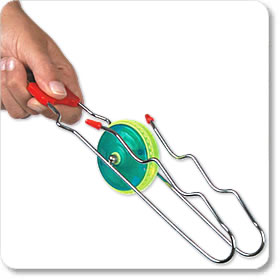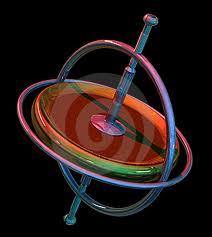Open a Door and Invite a Child to Walk Through
The best way to teach your child effectively is through inspired learning. Inspired learning happens when a child learns or asks questions by themselves because of their interest in the subject and not because of any compulsion.
 When I was a young girl one of the things we received each year for many Christmases was a gyroscope. We never got tired of getting them because they were so fascinating to play with.
When I was a young girl one of the things we received each year for many Christmases was a gyroscope. We never got tired of getting them because they were so fascinating to play with.
The first couple of times that I received this particular toy for Christmas I only wanted to play with it. I would pick it up and observe how it worked for long periods of time.
At about 9-10 I began wondering why it did what it did why it seemed to defy gravity or what use was it outside of a child’s toy. Maybe I asked my mom who would have replied “I don’t know”. I possibly asked my dad who would have said, “It’s too hard to explain”.
what use was it outside of a child’s toy. Maybe I asked my mom who would have replied “I don’t know”. I possibly asked my dad who would have said, “It’s too hard to explain”.
No one ever opened a door for me to walk through. I was ready to move on and engage with greater knowledge. I wanted to understand this amazing instrument. I was open to finding out how it was used beyond fascinating a child for a few weeks. It was my parent’s opportunity to inspire me and allow me to choose to engage in learning.
Creating an inspiring environment and responding to a child’s sparks was something that was foreign to my parents both for the times and their own family upbringing. In our family children did their thing, parents did theirs and learning was a “school” thing.
Yesterday I talked about the importance of play, of taking the hand of a child and walking along with them, opening a door and letting the child choose to walk through to greater learning. We need to walk with our children, not drag them around to fulfill our need that they learn. We need to open doors and invite children to enter, not try to push them through. It will help us to see play with new eyes!
In a series of articles I walked you through the steps of finding an idea you wanted to teach your child or responding to a Spark, by researching the information, getting your materials ready and then implementing the learning by using The Spark Station. This is important to effectively and efficiently use your time and to inspire children to love learning.
 I remind you of this because I want to use that pattern today to show you how to take an isolated item from the list of possible Spark Station materials and then link that to inspired learning. Because of that past pleasant memory of the gyroscope and because I am still interested in why they work I picked it from the list of possible Spark Station contents to demonstrate.
I remind you of this because I want to use that pattern today to show you how to take an isolated item from the list of possible Spark Station materials and then link that to inspired learning. Because of that past pleasant memory of the gyroscope and because I am still interested in why they work I picked it from the list of possible Spark Station contents to demonstrate.
If you put a gyroscope in your Spark Station and your child plays with it that is wonderful. At some later time that same child might ask you the same types of questions that I asked. How could you open the door and invite them, inspire them, to learn more?
I spent about 15 minutes on the computer doing some research. I started with one site which had links to all that I needed. http://www.howstuffworks.com/gyroscope.htm
This site showed:
Introduction to how gyroscopes worked
Precession
The cause of precession
Uses of gyroscopes
Lots more information
In the body of the article I found that bicycles and space shuttles use gyroscopes. An airplane uses about a dozen gyroscopes in everything from its compass to its autopilot. The Russian Mir space station uses 11 gyroscopes to keep its orientation to the sun , and the Hubble Space Telescope has a batch of navigational gyros as well. Gyroscopic effects are also central to things like yo-yos, Frisbees and boomerangs! Each topic had a link to more information. There was also a link to an activity on how to make a bycicle wheel gyroscope (scroll down to 1.3)
everything from its compass to its autopilot. The Russian Mir space station uses 11 gyroscopes to keep its orientation to the sun , and the Hubble Space Telescope has a batch of navigational gyros as well. Gyroscopic effects are also central to things like yo-yos, Frisbees and boomerangs! Each topic had a link to more information. There was also a link to an activity on how to make a bycicle wheel gyroscope (scroll down to 1.3)
That was interesting because I had seen a video on the site showing how a bicycle wheel gyroscope works. Children would be able to see how it works and then make one.
On my library list I would add books about bicycles, airplanes, the Hubble, and anything else I could find about gyroscopes.
When I look at the list of possible Spark Station contents, think of something I want to share with my children or catch a “spark”, I want to be prepared to respond. It doesn’t matter if we are talking about magnets, gyroscopes or slime. I want to know how to open the door of learning for them and invite them to enter. Maybe they will walk through!
Possibly Related Posts:
- 5 Creative Writing Exercises for Kids of All Ages
- 5 Ways to Help Your Child Think Like a Scientist
- To Waste or Not to Waste, That Is The Question
- Better Communication-Better Outcomes
- Children Learn Best When They Are Interested




{ 1 comment… read it below or add one }
I did this focusing on one thing from the closet: kites. It was amazing to find out all the things you can learn when playing with and making kites: culture, science, history, warfare, physics, biology, art, math, etc. The closet really is a fantastic tool!